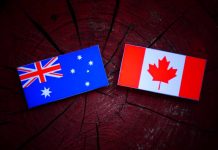The slow, but steady increase in Covid-19 cases across Asia, ex-India, is weighing on sentiment in early Asian trading. India’s situation dominated the weekend press, but across Japan, South Korea, Thailand and others in between, Covid-19 is undermining confidence in cyclical recovery that many, including the author, have priced into their H2 2021 outlooks.
In all honesty, it is much too soon to draw conclusions on this scenario, although we will have a much better picture, I believe, in a few weeks as the situation evolves. One thing is for sure, markets have priced in the pandemic as a sprint and not a marathon. That premise could come under stress in the weeks to come, although I sorely hope I am completely wrong on this front.
Economic data could overshadow Covid concerns
Pandemic nerves are likely to be drowned out this week as it progresses as the pace of the data calendar picks up. This week’s calendar is heavy with tier-1 releases, notably China’s Industrial Profits on Tuesday and Manufacturing and Non-Manufacturing PMIs on Friday in Asia. Today, the US releases Durable Goods, House Prices tomorrow, an FOMC decision plus GDP late on Wednesday, and finishes the week with Initial Jobless Claims and Personal Income/Expenditure. The US bond auction calendar is relatively quiet, with only 5-year and 7-year note auctions.
In Europe, Germany releases its IFO survey today and flash GDP for Q1 on Friday, which also sees pan-Europe inflation data announced. Today’s CDU Congress in Germany may also provide some fireworks.
Australia releases Inflation and RBA Trimmed Mean CPI on Wednesday, and ex-China, Asia’s calendar is busy as well. Singapore releases Industrial Production this afternoon, with South Korean Advance GDP for Q1 early tomorrow morning. Tomorrow also sees the latest Bank of Japan rate decision. Japan releases Retail Sales on Wednesday, followed by Malaysia’s Balance of Trade and Thailand Industrial Production. Friday has South Korean and Japan Industrial Production before the pan-Asia Markit PMIs released the following Monday.
Tucked in amongst that line-up is US earnings. Notably, the MAAFS report this week. Microsoft, Alphabet, Amazon, Facebook and Spotify. They should all have continued printing money; of more interest will be their outlook going forward and whether they are mollifying it, either by regulatory threats or the easing of the Zoom boom.
It was notable that US markets put the Biden capital gains tax increase quickly behind it on Friday, after much hand-wringing by markets on Thursday. Wall Street finished the week strongly as it convinced itself the measure would inevitably be watered down. Similarly, with a data calendar as juicy as this week, Monday morning Covid-19 nerves are likely to be quickly forgotten.
Two entities who will not forget, though, are the Bank of Japan and the FOMC. Having tinkered with their QE programme last month, the BOJ will be unchanged this week, although they will note the binary risks of the pandemic. Especially so as parts of Japan have entered Covid-19 restrictions.
The situation in India and elsewhere has played into the FOMC’s hands as well, with the world’s central banks having consistently hedged their easy money inflationary bets by pointing out the pandemic risks. Those expecting hints of a Fed taper will be sorely disappointed with the FOMC likely to be in “we told you so” mode. Net-net, the Bank of Japan and FOMC should be positive for the buy-everything trade.
Another area of complacency is the US bond market. Bond yields continue to ease, but if the US economy performs the way it is predicted over the coming months, it is hard to see the US 10-year staying around 1.50%; that number should probably start with a two. With the avalanche of data to come over the next two weeks, we should have a better idea on this front come Friday week after the Non-Farm Payrolls. Equities are at record highs, and a steepening of the US yield curve would pressure them globally, particularly in the pimped-up valuation universe of Wall Street. Gold, bitcoin, and selected EM Asian currencies would also feel the heat in this scenario.
Another warning sign is the rush of international companies to SPAC themselves on Wall Street. The simple reason, despite the corporate PR rhetoric, is that American’s will assign US valuations to anything remotely tech no matter where in the world they are based. Grab would not be worth USD40.0 billion anywhere else in the world except Wall Street. Nor would anywhere else accept a CEO holding 2.0% of the equity having 60% of the voting rights. The early investors will likely not care as SPAC-ing in the US will allow them liquidity to book profits and pass that issue on to US SPAC-holders. After ten years, Grab doesn’t even make money.
In a sense, I suspect Grab will represent “peak SPAC.” If something is too good to be true in the financial markets anywhere, my experience is that it always turns out to be the case. Only a front page of The Economist proclaiming “SPAC Forever” would be a more prominent warning sign that equity markets are overdue a correction. Add in the potential of the US bond yields to move higher, and the scene is set for an equity correction in the next couple of months.
Before my email box is bombarded, though, I do note that the world’s central banks with the decade-long free money pumps will have investors’ backs. Equity markets may endure a torrid correction, but I have little doubt that they will still finish the year higher than today.
Finally, my favourite “mainstream institutional the future is now” asset class, bitcoin, remains under pressure after weekend trading. In all honesty, I have no idea why and I shall not look for “facts” to fit the narrative. I will leave the “healthy correction” to the “institutional” experts. My feeling is that the market is long and wrong above USD60,000 of fiat currency, backed by tax-payer revenue, US dollars. As mentioned last week, bitcoin broke out of a rising wedge at USD56,000.00 on the 20th of April. My target remains USD42,000.00 because that’s what the knucklebones of my chart say. Having been pummelled over the weekend, Bitcoin is up around 6.0% today; maybe Elon tweeted, I know not.












